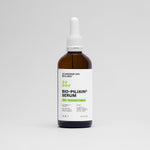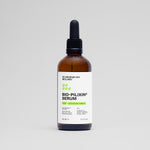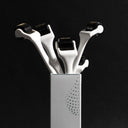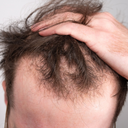Did you know that hair loss affects over 56 million people worldwide [1]? In the UK alone, 6.5 million men and 8 million women struggle with it [2]. By the time they're 70, half of all men and 40% of women will experience hair loss.
Losing hair can make you feel less attractive and more stressed. Almost half of men feel self-conscious when they start losing hair [3]. For women, 40% with hair loss have relationship issues, and 63% face job problems [4].
But here's the good news: you don't have to just accept hair loss. Begin by understanding your genetic risks and finding the right treatments. This can help you keep your hair longer.
Let's dive into the genetic keys to hair loss.
Table of content
What is Hair Loss?
Hair loss, or alopecia, is when hair falls out from where it usually grows. It can happen on your scalp or other body parts. Common causes include genetics, hormones, and certain health conditions or medications.
The most common type of hair loss is androgenetic alopecia. This is also known as male or female pattern baldness. It is due to a combination of genetic and hormonal factors that cause the gradual thinning of hair, eventually leading to baldness.
The Hair Growth Cycle: How Does Hair Grow and Fall Out?
To understand hair loss, we need to understand the hair growth cycle [5]. Each hair grows in four phases:
- Anagen (Growth Phase): This is when hair grows. Most hair (80%-90%) is in this phase, which lasts 2 to 6 years.
- Catagen (Transition Phase): This short phase lasts a few weeks. Less than 5% of hair is here.
- Telogen (Resting Phase): This phase lasts about 3 months. Hair doesn’t grow but stays attached.
- Exogen (Shedding Phase): This is when hair falls out. You shed around 100 hairs a day.
Genes can play a role in how long hair stays in each phase. This affects overall hair growth and loss. Let’s look at this in more detail.
As your leading source for hair health information over the past 4 years, we never compromise on accuracy. When it comes to your health, you deserve information you can truly rely on - and earning your trust is our top priority.
Here's how Scandinavian Biolabs ensures every piece of content meets the highest standards of accuracy and integrity:
- Credentialed Experts: Our reviewers are actively practicing doctors and medical researchers
- Stringent Reviews: Content undergoes rigorous editing by subject specialists and review by a practicing doctor.
- Evidence-Based: We rely on well-established research from trusted scientific sources like peer-reviewed journals and health authorities.
- Full Transparency: Our editorial standards, writer credentials, reviewer credentials, correction process, and funding are all publicly documented.
- Independent Voice: While we do promote products, we operate in a vacuum to business operations. Our main goal is just an unwavering commitment to providing medically-sound guidance.
You can count on Scandinavian Biolabs to consistently deliver the trustworthy health information you deserve. Read our Editorial Standards.
Androgenetic Alopecia: Is Hair Loss Really Genetic?
Androgenetic alopecia is the most common type of hair loss. It affects 80% of men and 50% of women. This condition is a mix of genetic and hormonal factors.
Your genes can make hair follicles more sensitive to dihydrotestosterone (DHT). DHT is a hormone that can shorten the hair growth phase and cause hair follicles to shrink. Thus, if you've inherited these genes your hair can become thinner and shorter over time. Eventually, hair follicles may shrink so much they stop producing hair. This is called follicular miniaturisation.
Several genes are involved in the development of androgenetic alopecia [6]. The androgen receptor (AR) gene is a central one to this process. Variations in this gene make hair follicles more sensitive to DHT. Similarly, the 5-alpha reductase gene helps convert testosterone to DHT. This also raises DHT levels.
Other genes can also contribute [7]. Research has found over 250 genetic locations linked to severe hair loss. For instance, the EDAR2 gene and genes in the WNT pathway also control hair growth. Thus, changes in these genes can disrupt normal hair growth, leading to hair loss.
Are There Differences Between Male and Female Pattern Baldness?
In men, hair loss usually starts with a receding hairline and thinning on the top of the head.
For women, hair loss happens all across the scalp, often leading to a wider centre part. The front hairline usually stays the same.
These varying patterns of genetic hair loss are due to hormones and genetics. For women, variations in genes like AR, EDAR2, and those in the WNT signalling pathway play a big role. For men, hormones like DHT have a stronger impact.
Can You Prevent, Treat, Or Cure Genetic Hair Loss?

Genetic hair loss cannot be prevented or cured, but there are ways to slow down and delay the process. These include FDA-approved medications and treatments which can be effective at managing your hair loss and pushing it back as much as possible. There are several holistic methods as well you can follow to make sure your follicles have as much support as possible. These include improving your diet, managing stress, and caring for your scalp.
Holistic Methods To Support Hair Growth
It is important to note that genetic hair loss cannot be treated by dietary changes, stress management, or scalp care alone. However, these holistic methods are key in ensuring that your follicles are in the best shape possible and give them the best chance at fending off hair loss combined with any other treatments you might have.
- Optimise Your Diet
While diet alone cannot fight genetic hair loss, it is crucial to support your follicles with the right nutrients. Eating the right foods can help slow hair loss. The Mediterranean Diet (MD) can be a great choice as it includes lots of vegetables, fruits, nuts, grains, and fish. It also uses healthy fats like olive oil and limits meat and dairy.
Even studies have shows that the MD can help with hair health [8]. This is because it is rich in polyphenols known to reduce inflammation and protect against hair damage by blocking harmful gene activity.
- Manage Stress
Managing stress is key to slowing hair loss [9]. High stress increases cortisol, a hormone that can harm hair follicles. Cortisol affects the hair follicle's growth cycle. It also reduces important skin elements like hyaluronan and proteoglycans by about 40%. This weakens hair structure and growth.
To combat this, here are some effective stress management techniques:
- Box Breathing: Inhale, hold, exhale, and hold again, each for four seconds.
- Guided Imagery: Visualise calming scenes to relax. This helps manage stress by distracting you from negative thoughts.
- Progressive Muscle Relaxation (PMR): Tense and relax different muscle groups to ease tension.
- Mindfulness Practices: Studies show mindfulness can reduce cortisol levels in hair by 88.8% [10]. Thus, practising techniques like journaling can help keep your hair healthier.
- Look After Your Hair and Scalp
Taking care of your scalp is key for healthy hair [11]. An unhealthy scalp can lead to inflammation, causing the weakening of follicles and potentially leading to hair loss.
Natural Ways To Address Genetic Hair Loss

There are several natural substances that are known for their ability to tackle hair loss and promote growth. While these are not approved by the FDA, they often have anecdotal and even some scientific evidence that they can be a useful addition to a hair growth routine.
Some of the most popular natural remedies include:
- Curcuma, or turmeric, has antioxidant properties. This means it can help protect your hair from harmful chemicals called free radicals. It also nourishes your hair follicles. Research shows that Curcuma extract can slow hair loss and increase hair growth [12].
- Pumpkin seed oil (PSO) is known for its ability to block dihydrotestosterone (DHT), a hormone that’s associated with genetic hair loss, especially in men. In a study with 76 men, those who took PSO for 24 weeks saw a 40% increase in hair, compared to a 10% increase in the placebo group [13].
- Caffeine is a well-known ingredient in the hair loss community. It works by supporting an increased blood flow and therefore more nutrient delivery to the scalp. It raises cyclic adenosine monophosphate levels, helping cells grow faster, which in turn can help improve hair growth. Research shows that even small amounts of caffeine can trigger hair follicle growth [14].
Pros of natural hair loss solutions:
- Easily accessible for most
- Cost-effective
- Generally safe with few side effects
Cons of natural hair loss solutions:
- Limited research
- May not work for everyone
Addressing Hair Loss With Biotechnology: Combining The Best of Nature And Science
Biotechnology has taken a hit on the hair loss market in recent years. More and more brands are discovering that combining natural ingredients, already proven to boost hair growth, with advanced technology can create safer and more effective solutions for hair loss.
Some of these innovative ingredients include:
- Capilia Longa™, a natural active derived from the stem cells of Curcuma longa. Rich in growth factors, it demonstrated up to 89% reduction in hair loss and up to 52% improvement in hair density in individual studies.
- HotFlux®, also known as Vanillyl Butyl Ether, a mild warming agent that can create a warm, tingling sensation on the scalp. This can improve blood flow – and so nutrient and oxygen delivery – to the scalp.
- Prodew® 500, an amino complex. Amino acids applied externally are known to create various cosmetic effects, such as moisturising, strengthening, visibly improving surface damage.
Pros of addressing hair loss with biotechnology:
- More effective than natural solutions
- Generally safe with few side effects
- Can be a great alternative for those vary about medications
Cons of addressing hair loss with biotechnology:
- Needs more time to gather extensive scientific evidence
- May not be widely available in all markets.
- May not be beneficial for advanced cases
FDA-Approved Treatments for Androgenetic Alopecia

While there may be several effective ways to address androgenetic alopecia, there are only a few acknowledged by the FDA and the medical community.
Minoxidil, most commonly known as the brand Rogaine, is a popular treatment for both men and women that helps hair grow longer and thicker. It works by keeping hair in the growth phase longer and opening blood vessel channels. Studies with 634 patients showed Minoxidil works well as a treatment to address hair loss [15].
Pros of minoxidil:
- Well-documented effectiveness in promoting hair growth.
- Easy to find and use.
- Effective for both men and women.
- Hair loss resumes if treatment is stopped.
- Potential for scalp irritation and unwanted hair growth in other areas.
- Not effective for everyone.
Finasteride, known as the brand Propecia, is another medical treatment for hair loss most commonly used by men. It works by blocking the enzyme that turns testosterone into DHT. Lowering DHT levels can help slow down and delay androgenetic alopecia. Studies with 458 patients showed Finasteride is effective in reducing hair loss [16].
Pros of finasteride:
- DHT Blocker: Effectively reduces hormone-related hair loss.
- Oral Medication: Easy to take as a daily pill.
- Proven Results: Backed by numerous clinical studies.
Cons of finasteride:
- Side Effects: Can include sexual dysfunction and other systemic effects.
- Male-Specific: Primarily used by men, not typically prescribed for women.
- Prescription Needed: Requires a doctor’s approval for use.
Low-Level Laser Light Therapy (LLLT) is a non-invasive treatment for hair loss. It uses red light to stimulate hair growth. Studies show that LLLT is can be effective for both men and women [19]. Large trials found that LLLT led to significant hair regrowth. This makes it a promising option if you’re struggling with hair loss, but don’t want to go down the medical path.
Pros of LLLT:
- No surgery or medication required.
- Effective for both men and women.
- Studies show significant hair regrowth.
- High initial investment for devices.
- Regular and consistent use is necessary.
- Not effective for all users.
Hair Transplant: Surgical Treatments for Advanced Hair Loss
Hair transplant can be a good option for those who have advanced hair loss with hair follicles that are shrunken to a point of no return. It works by taking follicles from an area of the scalp that’s not affected by the hair loss (usually the back of the head) and implanting them into the affected areas.
There are two main methods: FUT and FUE.
FUT (Follicular Unit Transplantation) is a traditional method. During this, a strip of scalp is removed from the back of the head and divided into tiny grafts. This is then implanted into balding areas. Research with 112 patients showed significant hair regrowth with FUT [17].
FUE (Follicular Unit Extraction) is a modern technique. Doctors extract and transplant individual hair follicles to balding areas. It is less invasive and leaves minimal scarring. A study with 20 patients showed its effectiveness. After 12 months, 78% of the transplanted follicles were still growing [18].
Pros of hair transplants:
- Provides long-lasting and often permanent hair regrowth.
- Can achieve a natural-looking hairline and density.
- Improves self-esteem and overall appearance.
Cons of hair transplants:
- Expensive procedure, often costing thousands of dollars.
- Includes risks like infection, scarring, and post-operative discomfort.
- Requires downtime and follow-up care, with variable results.
Emerging Treatments for Hair Loss

Constant research is ongoing into new treatments for hair loss. These new methods show promise in helping to regrow and prevent hair loss. Let's look at some of the latest advancements.
Platelet-Rich Plasma (PRP) Injections for Hair Loss
Platelet-Rich Plasma (PRP) therapy is a simple and effective treatment for hair loss.
Here’s how it works: first, a small amount of your blood is taken. Then, the blood is processed to concentrate the platelets. These concentrated platelets are injected into your scalp to help stimulate hair growth.
Research shows that PRP works well for hair loss. In fact, 83% of studies found PRP to be successful in treating hair thinning [20]. Plus, PRP has very few side effects.
Stem Cell Therapy
Researchers are investigating the potential of stem cells to regenerate hair follicles. This includes both autologous stem cell transplants (using the patient's own cells) and induced pluripotent stem cells.
Hair Cloning and Hair Follicle Regeneration
Scientists are working on techniques to clone hair follicles and regenerate them in the lab. This could potentially provide an unlimited supply of hair follicles for transplantation, which could address one of the limitations of hair transplants.
What is the Latest in Genetic Research for Hair Loss?
Recent genetic research is uncovering new ways to tackle hair loss. Scientists have found over 250 genetic markers linked to severe hair loss. Key genes like the AR gene and WNT pathway genes are crucial. These genes influence hair growth and shedding.
Researchers are also exploring gene therapies to target these genes. New treatments may soon address genetic causes of hair loss. This could lead to more effective ways to prevent and treat hair loss.
Takeaway
Understanding genetic hair loss and its treatments can help you take control. There are many ways to tackle hair loss. These include a healthy lifestyle and advanced treatments. Emerging genetic research also offers new hope for effective solutions.
At Scandinavian BioLabs, we offer a range of products designed to address your needs. Our solutions range from nourishing hair growth serums to gentle, effective shampoos. So whatever you're looking for, we've got you covered.
Ready to combat genetic hair loss? Discover our products today and start your journey to healthier, fuller hair.
References
[1] ReportLinker (2022) Hair Restoration Market – Growth, Trends, COVID-19 Impact, and Forecasts(2022 – 2027). Yahoo! Finance. Available at: https://finance.yahoo.com/news/hair-restoration-market-growth-trends-134100620.html
[2] NHS (2023) Men’s Health. NHS Church End Medical Centre. Available at: https://www.cemc.nhs.uk/clinics-and-services/mens-health/ [Accessed 2 August 2024]
[3] Sanghvi, S. (2022) UK male hair loss report. LloydsPharmacy. Available at: https://onlinedoctor.lloydspharmacy.com/uk/hair-loss-advice/uk-male-hair-loss-report [Accessed 2 August 2024]
[4] Hunt N, McHale S. The psychological impact of alopecia BMJ 2005; 331 :951 doi:10.1136/bmj.331.7522.951
[5] Qi, J., & Garza, L. A. (2014). An overview of alopecias. Cold Spring Harbor perspectives in medicine, 4(3), a013615. https://doi.org/10.1101/cshperspect.a013615
[6] GOKCE, N., BASGOZ, N., KENANOGLU, S., AKALIN, H., OZKUL, Y., ERGOREN, M. C., BECCARI, T., BERTELLI, M., & DUNDAR, M. (2022). An overview of the genetic aspects of hair loss and its connection with nutrition. Journal of Preventive Medicine and Hygiene, 63(2 Suppl 3), E228. https://doi.org/10.15167/2421-4248/jpmh2022.63.2S3.2765
[7] Ho CH, Sood T, Zito PM. Androgenetic Alopecia. [Updated 2024 Jan 7]. In: StatPearls [Internet]. Treasure Island (FL): StatPearls Publishing; 2024 Jan-. Available from: https://www.ncbi.nlm.nih.gov/books/NBK430924/
[8] Cannataro, R., Fazio, A., La Torre, C., Caroleo, M. C., & Cione, E. (2021). Polyphenols in the Mediterranean Diet: From Dietary Sources to microRNA Modulation. Antioxidants (Basel, Switzerland), 10(2), 328. https://doi.org/10.3390/antiox10020328
[9] Norelli SK, Long A, Krepps JM. Relaxation Techniques. [Updated 2023 Aug 28]. In: StatPearls [Internet]. Treasure Island (FL): StatPearls Publishing; 2024 Jan-. Available from: https://www.ncbi.nlm.nih.gov/books/NBK513238/
[10] Gimenez, L. B., Fernandes, M. N., Lacchini, R., Camargo Júnior, E. B., Victoria, K., Melchior, M., Pérez, R. G., & Reisdorfer, E. (2022). Mindfulness Practice Reduces Hair Cortisol, Anxiety and Perceived Stress in University Workers: Randomized Clinical Trial. Healthcare, 11(21), 2875. https://doi.org/10.3390/healthcare11212875
[11] Trüeb, R. M., Henry, J. P., Davis, M. G., & Schwartz, J. R. (2018). Scalp Condition Impacts Hair Growth and Retention via Oxidative Stress. International Journal of Trichology, 10(6), 262-270. https://doi.org/10.4103/ijt.ijt_57_18
[12] Pumthong, G., Asawanonda, P., Varothai, S., Jariyasethavong, V., Triwongwaranat, D., Suthipinittharm, P., Ingkaninan, K., Leelapornpisit, P., & Waranuch, N. (2012). Curcuma aeruginosa, a novel botanically derived 5α-reductase inhibitor in the treatment of male-pattern baldness: a multicenter, randomized, double-blind, placebo-controlled study. The Journal of dermatological treatment, 23(5), 385–392. https://doi.org/10.3109/09546634.2011.568470
[13] Cho, Y. H., Lee, S. Y., Jeong, D. W., Choi, E. J., Kim, Y. J., Lee, J. G., Yi, Y. H., & Cha, H. S. (2014). Effect of pumpkin seed oil on hair growth in men with androgenetic alopecia: a randomized, double-blind, placebo-controlled trial. Evidence-based complementary and alternative medicine : eCAM, 2014, 549721. https://doi.org/10.1155/2014/549721
[14] Fischer, T. W., Hipler, U. C., & Elsner, P. (2007). Effect of caffeine and testosterone on the proliferation of human hair follicles in vitro. International journal of dermatology, 46(1), 27–35. https://doi.org/10.1111/j.1365-4632.2007.03119.x
[15] Randolph, M., & Tosti, A. (2021). Oral minoxidil treatment for hair loss: A review of efficacy and safety. Journal of the American Academy of Dermatology, 84(3), 737–746. https://doi.org/10.1016/j.jaad.2020.06.1009
[16] Piraccini, B. M., Blume-Peytavi, U., Scarci, F., Jansat, J. M., Falqués, M., Otero, R., Tamarit, M. L., Galván, J., Tebbs, V., & Massana, E. (2022). Efficacy and safety of topical finasteride spray solution for male androgenetic alopecia: A phase III, randomized, controlled clinical trial. Journal of the European Academy of Dermatology and Venereology, 36(2), 286-294. https://doi.org/10.1111/jdv.17738
[17] Devjani, S., Ezemma, O., Kelley, K. J., Stratton, E., & Senna, M. (2023). Androgenetic Alopecia: Therapy Update. Drugs, 83(8), 701-715. https://doi.org/10.1007/s40265-023-01880-x
[18] Elariny, A. F., Ghozlan, N., Wasief, S., Moussa, A. E., & Eldeeb, M. E. (2022). Evaluation of efficacy of follicular unit extraction versus follicular unit extraction with platelet rich plasma in treatment of cicatricial alopecia. Journal of Cosmetic Dermatology, 21(11), 5931-5937. https://doi.org/10.1111/jocd.15213
[19] Pillai, J. K., & Mysore, V. (2021). Role of Low-Level Light Therapy (LLLT) in Androgenetic Alopecia. Journal of Cutaneous and Aesthetic Surgery, 14(4), 385-391. https://doi.org/10.4103/JCAS.JCAS_218_20
[20] Gentile, P., & Garcovich, S. (2019). Systematic Review of Platelet-Rich Plasma Use in Androgenetic Alopecia Compared with Minoxidil®, Finasteride®, and Adult Stem Cell-Based Therapy. International Journal of Molecular Sciences, 21(8), 2702. https://doi.org/10.3390/ijms21082702








